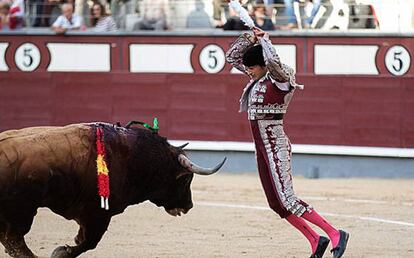From Aleppo to Madrid: a Syrian’s bullfighting odyssey
Hazem Al-Masri left his home at the age of 18 for Spain to fulfill his dream of becoming a torero

Sixteen years ago, Hazem Al-Masri decided to abandon tourism studies in his native Aleppo and leave Syria for Spain to fulfill his dream of becoming a bullfighter. Earlier this year, dressed in the traditional silver of the bandillero, he appeared for the first time at Madrid’s iconic Las Ventas bullring at the relatively late age of 34 as part of the cuadrilla, or team, of rising star Román, using his professional name of El Sirio. His performance delighted the crowd, earning him a standing ovation.
It was the culmination of an incredible journey that began as a teenager when he saw his first bullfight, on television.
“I was a just a kid, but those images made a real impression on me,” says Hazem, speaking from his home in the small town of Algemesí, in Spain’s Valencia region.
I thought being a bullfighter would be something really normal in Spain
“I didn’t even know what a bullfighter was, I didn’t understand anything. I thought the whole thing was some kind of illusion, but it also seemed like something unique, filled with beauty and truth,” he says.
In 2000, when he turned 18, Hazem quit his studies and traveled to Spain, settling in Valencia and seeking out members of the bullfighting community there. He was initially given a tourist visa and began working at an electronic warehouse to make ends meet. His parents stayed on in Syria: his father has since died, but his mother now lives in Spain.
“I came to Spain with the idea of becoming a bullfighter. I like risk and think of myself as brave. The problem was that I didn’t know the language: I didn’t even know where I could study how to perform the paseíllo, the ceremonial entrance of bullfighters into the ring.”
The first thing the young man did was change his name. “Hazem doesn’t suit you, a friend said to me: how about Alejandro – does that sound good to you? And since then everyone calls me that. The whole thing with El Sirio (The Syrian) came later.”
Over the next four years he learned Spanish, which he speaks with surprising savoir-faire, and then presented himself at the Escuela Taurina de Valencia, the region's bullfighting school. The first thing the director told him was that at the age of 22 he was too old.
I will never be content with being just another bullfighter
“I felt terrible. I didn’t understand how something that could be so typical of Spain could be so difficult. I thought being a bullfighter would be something really normal,” Hazem recalls.
After this initial rejection, he tried to train at rings where local bullfighters trained. He was so persistent that he was finally allowed to come along for a few evenings and learn a few of the techniques, albeit with an imaginary bull. He spent two years learning about the equipment used by bullfighters and how to fight, but also realized he would never make his debut as a novillero, or apprentice bullfighter, meaning that he would never become a matador and kill a bull in the ring.
“That’s just how it is: my maestro, Víctor Manuel Blázquez, told me. I am too old. And he told me I was better off trying out as a banderillero, one of three assistants who assist the matador in the ring by plunging the banderillas, the colorful barbed sticks, into the bull’s shoulder.”
Hazem Al-Masri initially thought bullfighting was some kind of illusion, but the images stayed with him
And so, seven years after arriving in Spain, Hazem made his debut in 2007 wearing a borrowed costume. That year he also invested €1,200 in a suit of lights, colored navy blue and silver, moving to Utiel, a small town in the heart of Valencia's wine growing region.
In 2011, opportunity knocked. A friend who was part of Román’s cuadrilla fell ill, and he stood in for him. Then, in 2014 he made his debut at Seville’s Maestranza bullring with the novillero Fernando Beltrán, an occasion he says he will never forget. This year he performed for three afternoons at Madrid’s Las Ventas with Román, and is hopeful about the future.
“I’ve a lot to learn, but I will never be content with being just another bullfighter. This is a big world and very beautiful, but very demanding. I hope Román earns a solid reputation and that I can continue being part of his team. That would make me proud.”
Hazem has had to balance his vocation as a bullfighter with other jobs and says that while he is happy in Spain he hasn’t forgotten his origins and the tragedy that has unfolded in Syria.
“I didn’t live through the war – my memories are of a peaceful country without unemployment and full of friendly people.”
English version by George Mills.
Tu suscripción se está usando en otro dispositivo
¿Quieres añadir otro usuario a tu suscripción?
Si continúas leyendo en este dispositivo, no se podrá leer en el otro.
FlechaTu suscripción se está usando en otro dispositivo y solo puedes acceder a EL PAÍS desde un dispositivo a la vez.
Si quieres compartir tu cuenta, cambia tu suscripción a la modalidad Premium, así podrás añadir otro usuario. Cada uno accederá con su propia cuenta de email, lo que os permitirá personalizar vuestra experiencia en EL PAÍS.
¿Tienes una suscripción de empresa? Accede aquí para contratar más cuentas.
En el caso de no saber quién está usando tu cuenta, te recomendamos cambiar tu contraseña aquí.
Si decides continuar compartiendo tu cuenta, este mensaje se mostrará en tu dispositivo y en el de la otra persona que está usando tu cuenta de forma indefinida, afectando a tu experiencia de lectura. Puedes consultar aquí los términos y condiciones de la suscripción digital.
More information
Últimas noticias
From Andorra to Gibraltar, a black market for Ozempic exploits its success: ‘They’re the most sought-after products in the world’
Magnets in their heads: How some animals guide themselves using the Earth’s magnetic field
From Hungary’s Orbán to Chile’s Kast: How Trump helps turbo charge the far right
The brief rise and retreat of Generation Z in Mexico
Most viewed
- Why we lost the habit of sleeping in two segments and how that changed our sense of time
- Trump’s obsession with putting his name on everything is unprecedented in the United States
- Charles Dubouloz, mountaineering star, retires at 36 with a farewell tour inspired by Walter Bonatti
- The Florida Keys tourist paradise is besieged by immigration agents: ‘We’ve never seen anything like this’
- Living in a motorhome due to soaring housing prices in Madrid: ‘I got used to it quickly, but I don’t idealize it’











































